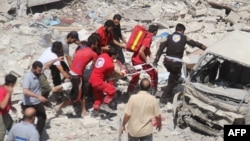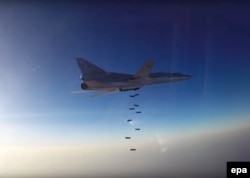On August 15, Al-Masdar News, an outlet with close ties to the Syrian government’s security apparatus, released photos of a Russian TU-22M3 long-distance strategic bomber, which were reportedly taken at the Hamadan airfield in Iran. By the next morning, Russian state-run media was running reports that Russian strategic bombers had taken off from the Iranian base and struck targets in Aleppo, Deir ez-Zor, and Idlib provinces in Syria.
Syrian activists and citizens posted videos of the massive devastation and reportedly high casualty rates on the ground as the result of air strikes, some of which were presumably the work of Russia’s TU-22M3s. While a statement from Russia’s Defense Ministry said the August 15 strikes had killed militants from the Islamic State (IS) extremist group and Jabhat Al-Sham (formerly the Al-Qaeda-linked Al-Nusra Front), Colonel Christopher Garver, a spokesman for the U.S. military’s Operation Inherent Resolve, told reporters that "we don't see concentrations of ISIS" in the areas of Aleppo and Idlib, where the majority of the Russian air strikes hit.
State Department spokesman Mark Toner told Voice of America that Russian jets appear to have continued their pattern of “continually, predominantly target[ing] moderate Syrian opposition forces.”
Since September 2015, the Russian Air Force has been conducting air strikes across Syria. Most of the aircraft used in these operations have been launched out of the Russian air base in Latakia, in northeastern Syria. TU-22M3s have been used by Russia in Syria, but they are too large for Russia’s air strips in the country, so they have flown from bases in Russia. The use of the Iranian air base shortens the length of the bombers’ sorties, which would potentially save the Russian Air Force time, fuel, and maintenance costs, although those savings could be at least partially offset by the expense of operating in a new country.
It is also questionable whether the strategic bombers add much to Russia’s operational capabilities. The anti-Assad rebels they appear to be targeting aren’t holding the kinds of heavily fortified ground positions or using sophisticated tanks that the missiles fired by the TU-22M3 were designed to destroy. Instead, Russia has mainly used strategic bombers in Syria to carpet-bomb cities and towns, a tactic that is devastating to civilians below. Russia has also used strategic bombers to launch cruise missiles, a move which many experts consider to be symbolic, rather than tactical, in nature.
The use of Russian strategic bombers, however, is not without purpose. First, when Russia starting using cruise missiles in the fall of 2015, those missiles had to travel through Iranian and Iraqi airspace, which meant those countries had to approve the flight plans. This week, once again, Russia sought clearance to use the airspace over Iran and Iraq to launch cruise missiles. Thus, Russia was signaling to its adversaries that its mission in Syria had legitimacy and had been approved by other countries.
Second, as so many of Russia’s air strikes have targeted armed groups that have fought IS and have received backing from the United States, the Russians were sending a message when these bombers first appeared, to Syrians -- and indeed the world -- that Moscow was willing to back its allies with the entire might of the Kremlin, and there was nothing anyone could do to stop them.
During the summer of 2015 that preceded the start of Russia's air campaign, the military of Syrian President Bashar al-Assad had lost significant ground to anti-Assad rebels who were cutting deeper and deeper into government territory. Russia's intervention, thus, was designed to reverse their momentum and crush Assad's opposition. It worked, for a time. Until last month, Syria's rebels were on the retreat in much of the country, as the Syrian government advanced with the help of the Russian Air Force, Russian mercenaries, Hizballah fighters, Shi'ite militias from Iraq, and Islamic Revolutionary Guard Corps commandos.
In the last month, however, Syrian rebels have broken the siege of Aleppo and have potentially reversed the momentum of the war once again, a testament to the weakness of the Assad military. Russia may once again be ramping up its direct involvement in the conflict in order to push the rebels back.
Third, not only did Russia prove that it, too, was still capable of waging a war beyond its immediate borders, it also demonstrated several previously untested weapons systems, with the potential to make lots of money in arms sales in the process.
Russia might also have more malign aims. In the fall of 2015, at the start of Russia’s bombing campaign, Raed Fares, a well-known Syrian activist living in Kafranbel, in Idlib Province, told me that despite the fact that the town was controlled by a U.S.-vetted moderate rebel group, the Forsan al-Haq Brigade, and IS had not held positions anywhere near the town in two years, a Russian air strike created the most spectacular and frightening explosion he had ever seen. In Kafranbel, a symbol of the anti-Assad revolution that has been heavily bombed by Assad since 2012, that’s saying something.
The result, for Fares, was a feeling of hopelessness.
“Assad has been killing us for five years, then Hizballah, and Iran, then Russia...All of them are killing us, but no one in the world cares for us,” he told me then. It seems that a key component of the pro-Assad coalition’s strategy is to chase people like Fares from Syria. If no one is left in the country but jihadists and Assad supporters, because moderates have either been killed, turned into refugees, or radicalized, then the Russian narrative that all those who oppose Assad are terrorists will finally become the truth.
Furthermore, the sowing of further chaos and the creation of yet more refugees also benefits Assad and Russia. Many more refugees will flee to Assad’s regional adversaries, making them weaker in the process. Others will flee to Europe, where far-right, sometimes pro-Kremlin, Euroskeptic political parties are helping trying to weaken the European Union from within.






